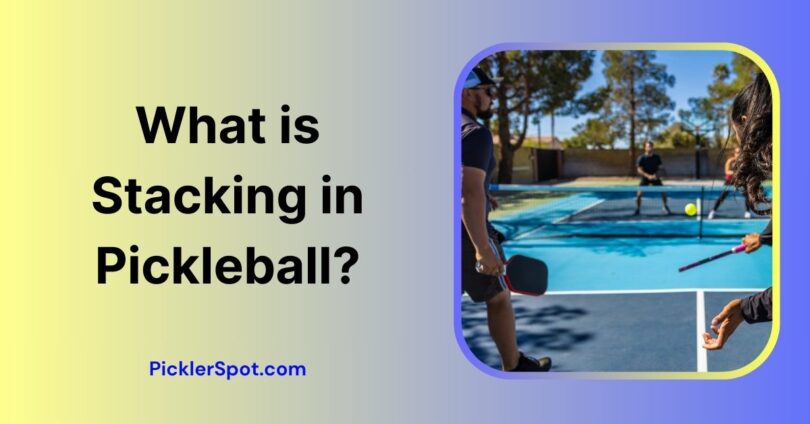Stacking is an interesting strategy where two players stand at the same side acting as a wingman all while masking each other’s weaknesses and flaws and amplifying strengths.
It’s a unique approach to double down on an opponent as it allows a team to exploit their opponent fairly easily, especially in the initial serving phase.
Keep in mind, that this is an advanced tier strategy so if you barely know where to start you may find yourself in a pickle because it may backfire on you in the most horrendous way imaginable and you might lose the match altogether.
But fret not, in this comprehensive guide, I will be explaining What Stacking in Pickleball how it can give you an edge, and where you shouldn’t use it.
Overview Of Stacking in Pickleball & How It Works
Stacking as the name suggests is basically the accumulation of two units at the same place over each other.
In Pickleball terms, in the court when there are two players standing at the same side before a serve or return, and once the ball is repelled or countered, both of them return to their assigned region.
Stacking requires tons of footwork and coordination, so it’s not like anyone could utilize this strategy right off the bat as having a partner with equivalent synergy is extremely necessary.
Typically, Stacking is Subdivided into Two types,
1. Cross Stack
The most effective form of the stack is known as Cross stack when one player stands at the deuce while the other resides on the ad side, it’s not particularly used by beginners, but once mastered by a team, it could easily empower them since it basically eliminates the flaws of a player if they have a weaker side.
2. Side Stack
Side Stacking allows both players to stand on each side, irrespective of Deuce or the ad, and is by far one the most sought-after strategies in court if a team is stacking as it requires a lesser form of communication as less chance of human errors is seen int.
When Is Stacking Allowed?
In general, there is no particular rule that prohibits the utilization of this strategy, however, in order to be used effectively, stacking is done when a ball is served or returned or when they are trying to play in defensive mode.
During defensive mode, stacking plays a pivotal role in preventing the other team from exploiting their weakness, henceforth, to reinforce the synergy of both players, a defensive stacking strategy is implemented.
Although aggressive stacking can also be implemented during a match it might be counterproductive since it drastically increases the room for errors and may result in collision violation due to the recklessness.
Benefits Of Stacking
While, it may have some downsides, if used correctly with proper timing, Stacking can prove wonders in the court for a whole host of reasons mentioned below.
- If a player has a better chance of repelling a ball with their stronger backhand, they can switch sides while stacking with their partner to execute shots that were originally meant for their partner which tends to have a weaker backhand approach.
- If you feel like another team is trying to cause fatigue to your teammate by constantly throwing the ball right at them, you can easily “have your teammate’s back” so they can catch a break by taking the lead.
- When played in defensive mode, stacking allows you to provide cover for your teammate while they flank on the front, this ensures you cover any misses that could possibly result in a fault.
- Lastly, it could also be an effective approach to catching your opponent off guard by confusing them by switching sides and breaking the rhythm of predictability
When You Should Avoid Stacking?
Although, at first glance, it might seem quite a lucrative approach to attain quick points over your opponents, in scenarios you need to completely avoid it altogether here is why,
1. Lack Of Skills
If you or your teammate is in the early phase of a learning curve, it might not be the best time to utilize stacking as it could cause confusion and even backfire altogether.
While stacking may seem easier to adapt, it can sometimes overwhelm an individual and put them in an awkward spot, henceforth, it’s in your best interest that you avoid it altogether.
2. Coordination Issues
If you are in a situation where you cannot communicate effectively, Stacking should be avoided like a plague because it creates toxicity in the court since it highly relies on coordination and footwork with uniform rhythm without proper coordination you are waiting for the trouble to pop up.
Coordination issues can also cause recklessness which is a trait highly frowned upon and is best that you avoid it because Pickeball is a gentleman’s game and such behavior shouldn’t be tolerated.
3. House Rules
If you are playing in tournaments or leagues, you must always adhere to the rules implemented by the authority. If the court management prevents the utilization of stacking, you shouldn’t exercise it since it could result in disqualification and even penalties.
Failure to comply with the house rules can also result in you or your teammate getting barred from the tournament which is the last thing you would want if you want to compete to build your career.
4. In Balanced Teams
This might seem a little bit shocking but the whole element of stacking is to mask and cover for each other weaknesses while amplifying your teammate’s strength. If you are playing with a teammate who has an equivalent strength and weakness, then there is virtually no point in stacking in the court.
In such scenarios, it would create an extra set of hoops that you have to jump through which makes the whole situation even more stressful and overwhelming than it already would be.
You can also read Dink Shot In Pickleball? – A Gentle But Reliable Jab
What is Stacking in Pickleball? And That’s a Wrap
Stacking certainly staggers weaker opponents if they can’t read through patterns or barely have synergy, however, if you feel like your opponent is adaptable, you might want to use it only in moderation since it could negatively impact your strategies altogether.
Try to implement variation and use sign gestures in order to communicate with your teammate, in that way, you can effectively counter almost any form of attack from your opponent with minimal effort.
That being said, this article has clarified any doubts corresponding to “What is Stacking in Pickleball and how it could help you become better in the court, feel free to comment below if you still have any doubts in your mind.









